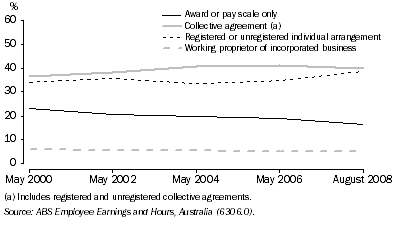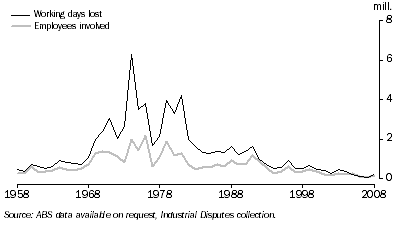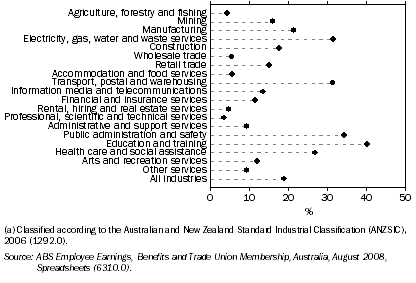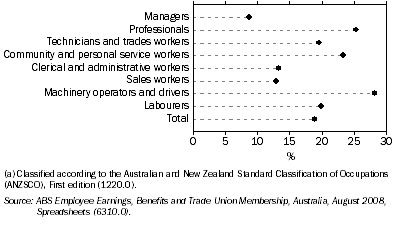WORKPLACE RELATIONS
Workplace relations can be regarded as the relationships and interactions in the labour market between employers and employees (and their representatives), and the intervention in these relations by governments, government agencies and tribunals (e.g. Fair Work Australia).
Historically, governments have regulated the Australian labour market to varying degrees. Changes to the structure or processes underpinning the workplace relations environment have generally followed changes in governments, and periods of social or economic change. For most of the last century, employee-employer relationships were shaped by highly centralised Commonwealth and state tribunal-based systems of conciliation and arbitration. However, since the late 1980s, the workplace relations environment in Australia has undergone significant change and is now characterised by more decentralised arrangements.
The field of workplace relations is complex and diverse and, for statistical purposes, is not easily measured. The ABS collects information on a number of topics to provide an insight into the state of the workplace relations environment, including the methods used for setting pay (i.e. awards, collective agreements and individual arrangements), industrial disputes, and trade union membership.
How pay is set
Information on the methods of setting the main part of employees' pay is collected in the EEH survey. Three different methods of setting pay are identified - awards, collective agreements, and individual arrangements.
Awards or pay scale only - awards are legally enforceable determinations made by federal or state industrial tribunals that set the terms of employment (pay and/or conditions), usually in a particular industry or occupation. From March 2006, pay rates for employees in the federal jurisdiction who were previously paid according to an award are now contained within the Australian Pay and Classification Scales (Pay Scales). An award or pay scale may be the sole mechanism used to set the pay and/or conditions for an employee or group of employees, or alternatively may be used in conjunction with an individual or collective agreement. Employees are classified to the award or pay scale only category if they were paid at the rate of pay specified in the award pay scale. If an employee was paid more than the rate of pay specified in the award or pay scale they are included in the individual arrangement category.
Collective agreements, which include enterprise and workplace agreements, are agreements between an employer (or group of employers) and a group of employees (or one or more unions or employee associations representing employees). Collective agreements set the terms of employment, and are usually registered with a state or federal industrial tribunal or authority.
Individual arrangements are arrangements between an employer and an individual employee for the terms of employment (pay and/or conditions) for the employee. Employees whose pay is set by an individual arrangement include those whose pay is set by an individual contract, registered individual agreement (e.g. an Australian Workplace Agreement), common law contract and employees receiving over award payments. Working proprietors of incorporated businesses are included in the individual arrangements category within EEH.
In August 2008, 40% of employees had their pay set by collective agreement, 39% by a registered or unregistered individual arrangement and 17% of employees had their pay set by award or pay scale only. Working proprietors of incorporated businesses accounted for 5% of employees (graph 8.49).
The proportion of employees who had their pay set by an award or pay scale decreased from 19% in May 2006 to 17% in August 2008. The coverage of this method of setting pay has declined over the last 8 years, from 23% in May 2000 to 17% in August 2008. For registered and unregistered individual arrangements, there was a 4 percentage point increase between May 2006 (35%) and August 2008 (39%). The proportion of employees whose pay was set by a collective agreement had a 1 percentage point decrease between May 2006 (41%) and May 2008 (40%).
8.49 METHODS OF SETTING PAY

In August 2008 nearly half (45%) of employees in the private sector had their pay set by an unregistered individual arrangement (i.e. which was not registered with a federal or state tribunal) and a further 26% of employees in the private sector had their pay set by a registered collective agreement. In contrast, almost all (96%) of the public sector employees had their pay set by a registered collective agreement (table 8.50).
The proportion of female employees who had their pay set by award or pay scale only was 20%, compared with 13% of male employees. Collective agreements were also a more common method of setting pay for female employees (43%) than for male employees (37%), while registered or unregistered individual arrangements were more common amongst male employees than female employees (43% compared with 34%). Male employees were twice as likely (8%) to be working proprietors of incorporated businesses than female employees (4%).
8.50 METHODS OF SETTING PAY, Proportion of employees, By sector - August 2008 |
|
 |  | Collective Agreement | Individual Arrangement |  |
 | Award or pay scale only | Registered | Unregistered | Registered | Unregistered | Working Proprietor of Incorporated Business | Total | All methods of setting pay |
 | % | % | % | % | % | % | % | % |
Males |
|
| Private Sector | 15.7 | 25.2 | *0.6 | 2.7 | 47.5 | 8.3 | 58.6 | 100.0 |
| Public Sector | *0.3 | 94.5 | 0.9 | 1.2 | 3.1 | . . | 4.3 | 100.0 |
| All Sectors | 13.3 | 35.9 | 0.6 | 2.5 | 40.7 | 7.0 | 50.2 | 100.0 |
Females |
|
| Private Sector | 25.8 | 26.1 | 0.8 | 2.0 | 41.5 | 3.8 | 47.3 | 100.0 |
| Public Sector | *0.5 | 97.0 | *0.3 | 0.9 | 1.3 | . . | 2.2 | 100.0 |
| All Sectors | 19.9 | 42.6 | 0.7 | 1.8 | 32.2 | 2.9 | 36.9 | 100.0 |
Persons |
|
| Private Sector | 20.4 | 25.6 | 0.7 | 2.4 | 44.7 | 6.2 | 53.3 | 100.0 |
| Public Sector | *0.4 | 96.0 | 0.5 | 1.1 | 2.0 | . . | 3.1 | 100.0 |
| All Sectors | 16.5 | 39.2 | 0.6 | 2.2 | 36.5 | 5.0 | 43.7 | 100.0 |
|
| * estimate has a relative standard error of 25% to 50% and should be used with caution |
| . . not applicable |
| Source: ABS Employee Earnings and Hours, Australia, August 2008 (6306.0). |
The use of the various methods of setting pay differs between occupation groups (table 8.51). Collective agreements were most common for Professionals (52%) and least common for Managers (20%). Registered or unregistered individual arrangements were the most common method of setting pay for Managers (59%), Clerical and administrative workers (47%) and Technicians and trades workers (46%). Award or pay scale only as a method of setting pay was highest for Community and personal service workers (32%), Sales workers (31%) and Labourers (30%).
8.51 METHODS OF SETTING PAY, Proportion of employees, By occupation(a) - August 2008 |
|
 |  |  | Individual Arrangement |  |
 | Award or pay scale only | Collective agreement(b) | Registered or unregistered | Working proprietor of incorporated business | Total | All methods of setting pay |
 | % | % | % | % | % | % |
|
| Managers | 2.3 | 19.8 | 59.0 | 18.9 | 77.9 | 100.0 |
| Professionals | 4.2 | 52.4 | 37.7 | 5.6 | 43.3 | 100.0 |
| Technicians and trades workers | 18.4 | 28.6 | 45.7 | 7.3 | 53.0 | 100.0 |
| Community and personal service workers | 31.7 | 46.6 | 20.9 | *0.8 | 21.7 | 100.0 |
| Clerical and administrative workers | 10.7 | 38.6 | 46.8 | 3.9 | 50.7 | 100.0 |
| Sales workers | 30.5 | 36.5 | 31.7 | 1.3 | 33.0 | 100.0 |
| Machinery operators and drivers | 12.7 | 44.8 | 39.0 | 3.5 | 42.5 | 100.0 |
| Labourers | 29.8 | 41.0 | 27.8 | *1.4 | 29.2 | 100.0 |
| Total all occupations | 16.5 | 39.8 | 38.7 | 5.0 | 43.7 | 100.0 |
|
| * estimate has a relative standard error of 25% to 50% and should be used with caution |
| (a) Classified according to the Australian and New Zealand Standard Classification of Occupations (ANZSCO), First edition (1220.0). |
| (b) Includes registered and unregistered collective agreements. |
| Source: ABS Employee Earnings and Hours, Australia, August 2008 (6306.0). |
The industries with the highest proportion of employees with their pay set by collective agreements were Public administration and safety (88%) and Education and training (81%) (table 8.52). This is consistent with the high proportion of employees in the public sector who had their pay set by collective agreements (96%). With one in two employees having their pay set by award or pay scale only, Accommodation and food services has the highest proportion of employees (50%) for this method of setting pay. Registered and unregistered individual arrangements were most common in the Wholesale trade (76%) and Professional, scientific and technical services (71%) industries and least common in Public administration and safety (8%) and Education and training (10%).
8.52 METHODS OF SETTING PAY, By industry(a) - August 2008 |
|
 |  |  | Individual Arrangement |  |  |
 | Award or pay scale only | Collective agreement(b) | Registered or unregistered | Working proprietor of incorporated business | Total | All methods of setting pay |
 | % | % | % | % | % | % |
|
| Mining | *1.2 | 30.9 | 66.1 | 1.8 | 67.9 | 100.0 |
| Manufacturing | 12.2 | 29.9 | 54.3 | 3.6 | 57.9 | 100.0 |
| Electricity, gas, water and waste services | *5.4 | 67.5 | 25.8 | 1.2 | 27.0 | 100.0 |
| Construction | 9.1 | 25.6 | 49.1 | 16.1 | 65.3 | 100.0 |
| Wholesale trade | 9.0 | 10.1 | 75.5 | 5.3 | 80.8 | 100.0 |
| Retail trade | 28.9 | 36.2 | 31.1 | 3.8 | 34.9 | 100.0 |
| Accommodation and food services | 50.3 | 19.3 | 28.4 | 2.1 | 30.5 | 100.0 |
| Transport, postal and warehousing | 8.3 | 48.9 | 35.9 | 6.9 | 42.8 | 100.0 |
| Information media and telecommunications | 5.6 | 31.1 | 59.2 | 4.1 | 63.3 | 100.0 |
| Financial and insurance services | *2.2 | 38.9 | 53.0 | 6.0 | 59.0 | 100.0 |
| Rental, hiring and real estate services | 20.2 | *11.9 | 57.5 | 10.4 | 67.9 | 100.0 |
| Professional, scientific and technical services | 5.4 | 8.6 | 70.9 | 15.0 | 85.9 | 100.0 |
| Administrative and support services | 33.9 | 15.7 | 48.0 | 2.5 | 50.5 | 100.0 |
| Public administration and safety | *3.6 | 88.2 | 7.9 | *0.3 | 8.2 | 100.0 |
| Education and training | *8.4 | 81.2 | 9.7 | *0.7 | 10.4 | 100.0 |
| Health care and social assistance | 17.2 | 64.5 | 16.2 | 2.1 | 18.2 | 100.0 |
| Arts and recreation services | 14.2 | 37.9 | 43.6 | 4.3 | 47.9 | 100.0 |
| Other services | 25.4 | 7.3 | 58.2 | 9.1 | 67.3 | 100.0 |
| Total all industries | 16.5 | 39.8 | 38.7 | 5.0 | 43.7 | 100.0 |
|
| * estimate has a relative standard error of 25% to 50% and should be used with caution |
| (a) Classified according to the Australian and New Zealand Standard Industrial Classification (ANZSIC), 2006 (1292.0). |
| (b) Includes registered and unregistered collective agreements. |
| Source: ABS Employee Earnings and Hours, Australia, August 2008 (6306.0). |
Industrial disputes
The ABS defines an industrial dispute as a disagreement over an issue or group of issues between an employer and its employees, which results in employees ceasing work. Industrial disputes comprise: strikes, which are a withdrawal from work by a group of employees; and lockouts, which are a refusal by an employer or group of employers to permit some or all of their employees to work.
This section presents statistics on industrial disputes involving work stoppages of ten or more working days lost. 'Working days lost' refers to working days lost by employees directly and indirectly involved in the dispute. Directly involved employees are those who actually participated in the dispute. Indirectly involved employees are those who were stood down at the location where the stoppage occurred, but who were not themselves parties to the dispute.
Graph 8.53 shows that the number of working days lost per year, and the number of employees involved, have fluctuated from year to year, but have decreased over the last two decades.
8.53 Industrial Disputes

There were 196,500 working days lost due to industrial disputes in 2008, an increase from the 49,700 working days lost in 2007 (table 8.54). There were also more disputes in 2008 than in 2007 (177 compared with 135). The average number of working days lost per dispute also increased (from 368 to 1,110). From 2007 to 2008, the number of employees involved in industrial disputes increased from 36,000 to 172,900.
8.54 INDUSTRIAL DISPUTES |
|
 | Disputes | Employees involved | Working days lost | Working days lost per dispute |
 | no. | ’000 | ’000 | no. |
|
| 2004 | 692 | 194.0 | 379.8 | 549 |
| 2005 | 472 | 241.0 | 228.3 | 484 |
| 2006 | 202 | 122.7 | 132.6 | 656 |
| 2007 | 135 | 36.0 | 49.7 | 368 |
| 2008 | 177 | 172.9 | 196.5 | 1 110 |
|
| Source: ABS data available on request, Industrial Disputes collection. |
Table 8.55 shows that from 2007 to 2008, the number of working days lost per thousand employees increased from 5 to 21. All industries recorded increases between 2007 and 2008, except for Coal mining and Other manufacturing. The Education and Health and community services industry grouping recorded the largest increase in working days lost per thousand employees between 2007 and 2008 (from 11 to 76).
8.55 WORKING DAYS LOST PER THOUSAND EMPLOYEES, By selected industries(a) |
|
 |  | 2004 | 2005 | 2006 | 2007 | 2008 |
 |  | no. | no. | no. | no. | no. |
|
| Mining |  |  |  |  |  |
 | Coal | 294.5 | 500.1 | 97.1 | 139.4 | 52.7 |
 | Other | 117.5 | 27.2 | 13.5 | 0.5 | 2.3 |
| Manufacturing |  |  |  |  |  |
 | Metal products; Machinery and equipment | 71.7 | 103.7 | 102.1 | 20.3 | 30.1 |
 | Other | 34.1 | 27.7 | 12.9 | 11.9 | 6.6 |
| Construction | 223.7 | 153.8 | 24.0 | 10.1 | 19.9 |
| Transport and storage; Communication services | 37.9 | 20.0 | 15.8 | 3.2 | 5.3 |
| Education; Health and community services | 81.8 | 28.9 | 29.2 | 11.4 | 75.7 |
| Other industries(b) | 10.0 | 2.2 | 1.7 | 0.4 | 3.4 |
| All industries | 45.5 | 26.4 | 14.9 | 5.4 | 21.0 |
|
| (a) Classified according to the Australian and New Zealand Standard Industrial Classification (ANZSIC), 1993 (1292.0). |
| (b) Includes: Agriculture, forestry and fishing; Electricity, gas and water supply; Wholesale trade; Retail trade; Accommodation, cafes and restaurants; Finance and insurance; Property and business services; Government administration and defence; Cultural and recreational services; and Personal and other services. |
| Source: ABS data available on request, Industrial Disputes collection. |
Trade union membership
A trade union is defined as an organisation, consisting predominantly of employees, whose principal activities include the negotiation of rates of pay and conditions of employment for its members. In August 2008 there were 1.8 million employees who were trade union members. This represents 19% of all employees. Table 8.56 shows in 2008 the public sector had a higher proportion of employees with trade union membership than the private sector (42% compared with 14%).
Graph 8.57 shows that the rate of trade union membership peaked at 61% in 1962, before declining rapidly between 1962 and 1970. This period was followed by increasing membership during the 1970s. Since then the proportion of employees who were trade union members has steadily declined.
8.57 Trade Union Membership, Proportion of employees who were^trade union members

Some of the factors contributing to the decline in trade union membership include the changing workplace relations environment and the changing industry composition of the workforce, for example, the emergence of industries that are not highly unionised. Another factor in the decline in trade union membership is the increase in part-time and casual employment. These types of employment have historically been less unionised than full-time employment.
Graph 8.58 shows that the level of trade union membership varied considerably across industries, with the Education and training (40%), Public administration and safety (34%), Electricity, gas, water and waste services (32%), and Transport, postal and warehousing (31%) industries being the most unionised in 2008. The least unionised industries were Professional, scientific and technical services and Agriculture, forestry and fishing, both at 4%. Rental, hiring and real estate services, Wholesale trade and Accommodation and food services were the next least unionised industries, all at 5%.
8.58 Employees who were trade union members, By industry(a)
- August 2008

Graph 8.59 shows that the level of trade union membership also varied considerably across occupation groups, with Machinery operators and drivers (28%), Professionals (25%), and Community and personal service workers (23%) being the most unionised in 2008. The least unionised occupation group was Managers at 9%.
8.59 Employees who were trade union members, ^By occupation(a)
- August 2008

 Print Page
Print Page